What is ISO 45001:2018 Occupational Health and Safety Management Systems?
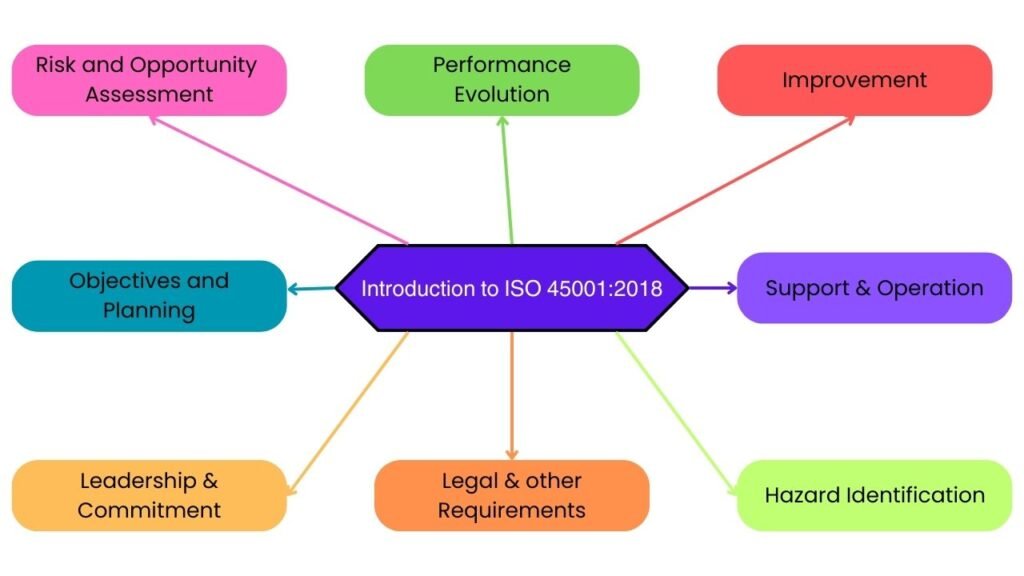
ISO 45001:2018 is an international standard for occupational health and safety (OH&S) management systems. It provides a framework for organizations to improve employee safety, reduce workplace risks, and create better, safer working conditions. Published by the International Organization for Standardization (ISO), this standard aims to help organizations proactively improve their OH&S performance.
What are the Key Elements of ISO 45001
-
- Risk and Opportunity Assessment
-
- Objectives and planning
-
- Leadership & commitment
-
- Performance Evolution
-
- Legal & other requirements
-
- Improvement
-
- Support & operation
-
- Hazard identification
Structure of ISO 45001:2018 – Clause Wise:
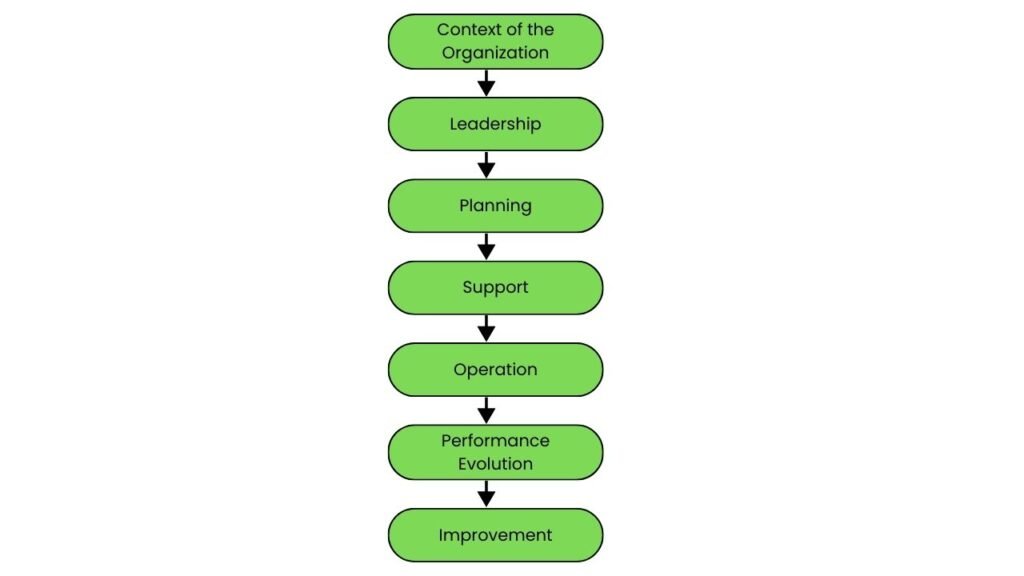
Clause 4: Context of the Organization
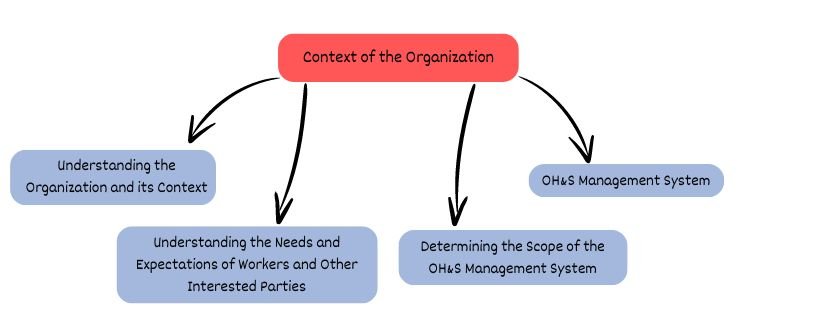
-
- 4.1 Understanding the Organization and its Context: requires organizations to determine external and internal issues that are relevant to their purpose and affect their ability to achieve the intended outcomes of their OH&S management system.
-
- 4.2 Understanding the Needs and Expectations of Workers and Other Interested Parties: Organizations must identify the needs and expectations of workers and other interested parties relevant to the OH&S management system.
-
- 4.3 Determining the Scope of the OH&S Management System: Organizations must establish the boundaries and applicability of the OH&S management system to define its scope.
-
- 4.4 OH&S Management System: Organizations must establish, implement, maintain, and continually improve an OH&S management system, including the processes needed and their interactions.
Clause 5: Leadership and Worker Participation
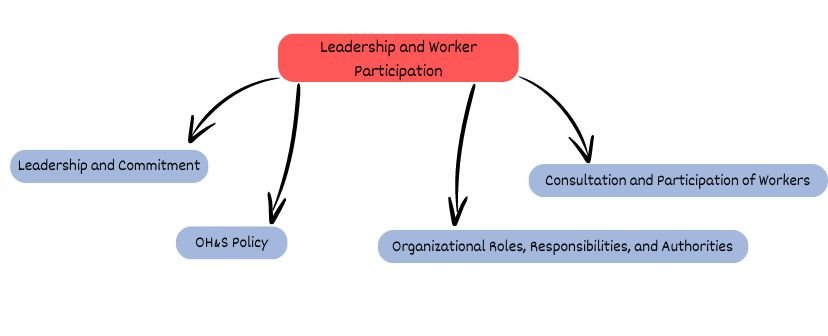
-
- 5.1 Leadership and Commitment: Top management must demonstrate leadership and commitment with respect to the OH&S management system.
-
- 5.2 OH&S Policy: Top management must establish, implement, and maintain an OH&S policy.
-
- 5.3 Organizational Roles, Responsibilities, and Authorities: Top management must ensure that responsibilities and authorities for relevant roles are assigned and communicated.
-
- 5.4 Consultation and Participation of Workers: Organizations must establish processes for consultation and participation of workers at all applicable levels and functions.
Clause 6: Planning
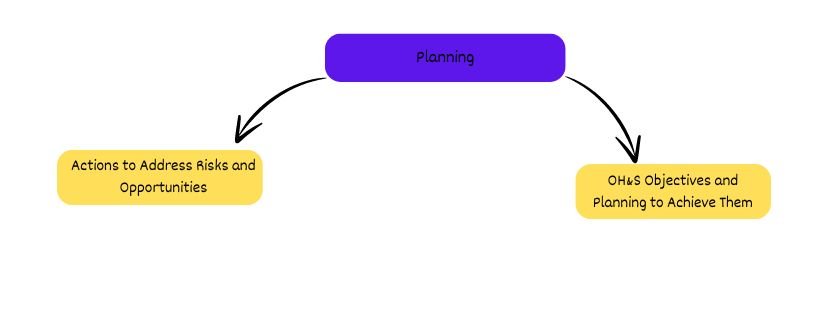
-
- 6.1 Actions to Address Risks and Opportunities: Organizations must plan actions to address risks and opportunities, including:
-
- 6.1.1 General: Requirements for determining and addressing risks and opportunities.
-
- 6.1.2 Hazard Identification and Assessment of Risks and Opportunities: Processes for hazard identification and assessment of OH&S risks and opportunities.
-
- 6.1.3 Determination of Legal and Other Requirements: Identifying and accessing legal and other requirements.
-
- 6.1.4 Planning Action: Planning actions to address risks and opportunities.
-
- 6.1 Actions to Address Risks and Opportunities: Organizations must plan actions to address risks and opportunities, including:
-
- 6.2 OH&S Objectives and Planning to Achieve Them: Organizations must establish OH&S objectives and plan how to achieve them.
-
- 6.2.1 OH&S Objectives: Setting measurable OH&S objectives.
-
- 6.2.2 Planning to Achieve OH&S Objectives: Establishing plans to achieve the objectives.
-
- 6.2 OH&S Objectives and Planning to Achieve Them: Organizations must establish OH&S objectives and plan how to achieve them.
Clause 7: Support
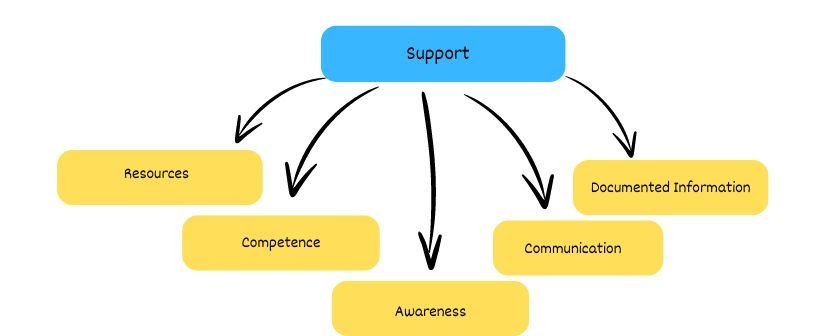
-
- 7.1 Resources: Determining and providing the resources needed for the OH&S management system.
-
- 7.2 Competence: Ensuring that workers are competent based on appropriate education, training, or experience.
-
- 7.3 Awareness: Ensuring that workers are aware of the OH&S policy, their contributions to the OH&S management system, and the implications of not conforming to the requirements.
-
- 7.4 Communication: Establishing processes for internal and external communication relevant to the OH&S management system.
-
- 7.5 Documented Information: Requirements for maintaining and controlling documented information required by the OH&S management system.
Clause 8: Operation
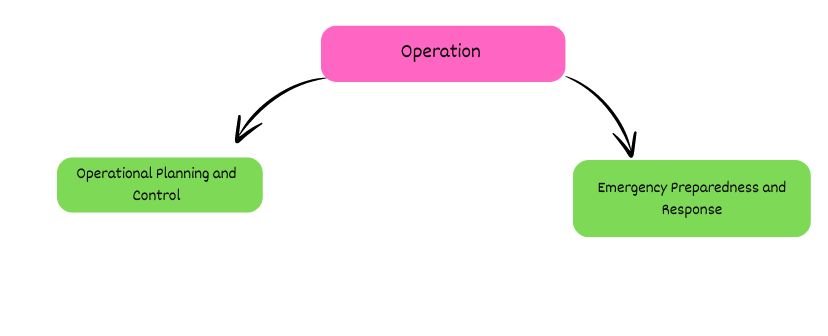
-
- 8.1 Operational Planning and Control: Planning, implementing, and controlling the processes needed to meet the requirements of the OH&S management system.
-
- 8.2 Emergency Preparedness and Response: Establishing processes to prepare for and respond to potential emergency situations.
Clause 9: Performance Evaluation
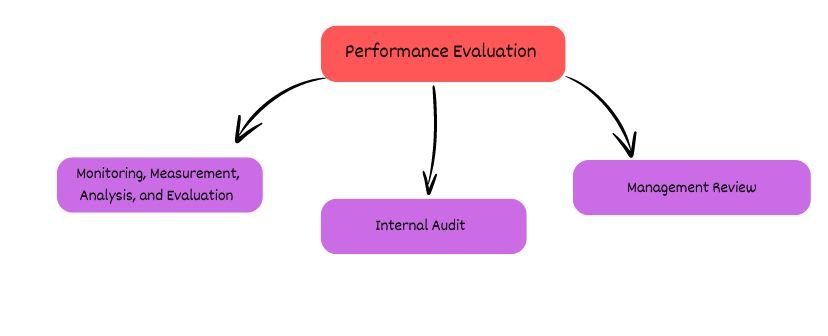
-
- 9.1 Monitoring, Measurement, Analysis, and Evaluation: Determining what needs to be monitored and measured, including:
-
- 9.1.1 General: Requirements for monitoring, measurement, analysis, and evaluation.
-
- 9.1.2 Evaluation of Compliance: Evaluating compliance with legal and other requirements.
-
- 9.1 Monitoring, Measurement, Analysis, and Evaluation: Determining what needs to be monitored and measured, including:
-
- 9.2 Internal Audit: Conducting internal audits at planned intervals to provide information on whether the OH&S management system conforms to the organization’s requirements and the standard.
-
- 9.3 Management Review: Top management must review the organization’s OH&S management system at planned intervals to ensure its continuing suitability, adequacy, and effectiveness.
Clause 10: Improvement
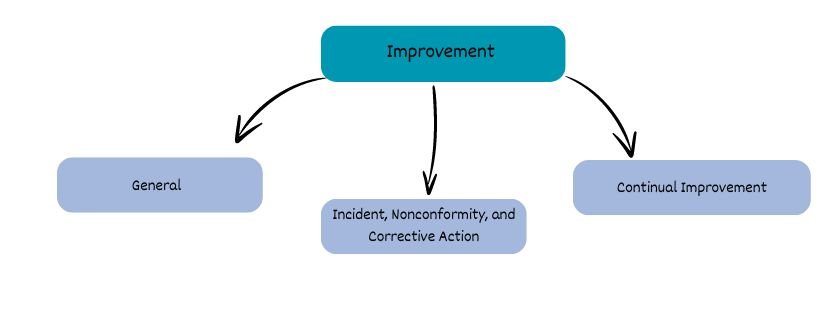
-
- 10.1 General: Determining opportunities for improvement and implementing necessary actions to achieve the intended outcomes of the OH&S management system.
-
- 10.2 Incident, Nonconformity, and Corrective Action: Establishing processes for reporting, investigating, and taking action on incidents and nonconformities.
-
- 10.3 Continual Improvement: Continually improving the suitability, adequacy, and effectiveness of the OH&S management system.
Clause-wise Audit Checklist for ISO 45001:2018
Here’s a detailed audit checklist structured around the main clauses of ISO 45001:2018:
Clause 4: Context of the Organization
-
- 4.1 Understanding the organization and its context
-
- Have the internal and external issues relevant to the OH&S management system been identified?
-
- Are these issues documented and regularly reviewed?
-
- 4.1 Understanding the organization and its context
-
- 4.2 Understanding the needs and expectations of workers and other interested parties
-
- Have the needs and expectations of workers and other interested parties been determined?
-
- Are these documented and reviewed periodically?
-
- 4.2 Understanding the needs and expectations of workers and other interested parties
-
- 4.3 Determining the scope of the OH&S management system
-
- Is the scope of the OH&S management system defined and documented?
-
- Does the scope consider all relevant factors, including external and internal issues?
-
- 4.3 Determining the scope of the OH&S management system
-
- 4.4 OH&S Management System
-
- Is the OH&S management system established, implemented, maintained, and continually improved according to the standard requirements?
-
- 4.4 OH&S Management System
Clause 5: Leadership and Worker Participation
-
- 5.1 Leadership and Commitment
-
- Are top management demonstrating leadership and commitment to the OH&S management system?
-
- Is there evidence of top management involvement and accountability in OH&S performance?
-
- 5.1 Leadership and Commitment
-
- 5.2 OH&S Policy
-
- Is there an OH&S policy that is appropriate, documented, and communicated within the organization?
-
- Is the policy available to interested parties?
-
- 5.2 OH&S Policy
-
- 5.3 Organizational roles, responsibilities, and authorities
-
- Are roles, responsibilities, and authorities for the OH&S management system assigned and communicated?
-
- Are workers at all levels involved in the OH&S management system?
-
- 5.3 Organizational roles, responsibilities, and authorities
-
- 5.4 Consultation and participation of workers
-
- Are mechanisms in place to ensure the consultation and participation of workers?
-
- Are workers’ views considered in decision-making processes?
-
- 5.4 Consultation and participation of workers
Clause 6: Planning
-
- 6.1 Actions to address risks and opportunities
-
- Have risks and opportunities that could affect the OH&S management system been identified?
-
- Are there plans to address these risks and opportunities?
-
- 6.1 Actions to address risks and opportunities
-
- 6.1.2 Hazard identification and assessment of risks and opportunities
-
- Are procedures in place for hazard identification?
-
- Are risks and opportunities regularly assessed and documented?
-
- 6.1.2 Hazard identification and assessment of risks and opportunities
-
- 6.1.3 Determination of legal requirements and other requirements
-
- Are applicable legal and other requirements identified and kept up to date?
-
- Is there a system to ensure compliance with these requirements?
-
- 6.1.3 Determination of legal requirements and other requirements
-
- 6.1.4 Planning action
-
- Are actions to address risks and opportunities, legal requirements, and OH&S objectives planned and implemented?
-
- 6.1.4 Planning action
-
- 6.2 OH&S objectives and planning to achieve them
-
- Are OH&S objectives established, documented, and communicated?
-
- Are plans to achieve OH&S objectives developed, implemented, and monitored?
-
- 6.2 OH&S objectives and planning to achieve them
Clause 7: Support
-
- 7.1 Resources
-
- Are adequate resources provided for the establishment, implementation, maintenance, and continual improvement of the OH&S management system?
-
- 7.1 Resources
-
- 7.2 Competence
-
- Are workers competent on the basis of appropriate education, training, or experience?
-
- Is there a system to evaluate and ensure the competence of workers?
-
- 7.2 Competence
-
- 7.3 Awareness
-
- Are workers aware of the OH&S policy, their contributions to the OH&S management system, and the implications of non-conformance?
-
- 7.3 Awareness
-
- 7.4 Communication
-
- Are internal and external communication processes established and implemented?
-
- Is relevant OH&S information communicated effectively?
-
- 7.4 Communication
-
- 7.5 Documented information
-
- Is documented information required by the OH&S management system established, maintained, and controlled?
-
- Are procedures in place for the creation, updating, and control of documented information?
-
- 7.5 Documented information
Clause 8: Operation
-
- 8.1 Operational planning and control
-
- Are processes for operational planning and control established and implemented?
-
- Are controls in place to manage the risks associated with OH&S?
-
- 8.1 Operational planning and control
-
- 8.1.2 Eliminating hazards and reducing OH&S risks
-
- Are methods for eliminating hazards and reducing OH&S risks implemented and reviewed regularly?
-
- 8.1.2 Eliminating hazards and reducing OH&S risks
-
- 8.1.3 Management of change
-
- Are changes that affect OH&S performance managed effectively?
-
- Are risks and opportunities associated with changes assessed?
-
- 8.1.3 Management of change
-
- 8.1.4 Procurement
-
- Are OH&S requirements integrated into procurement processes?
-
- Are suppliers and contractors required to conform to OH&S requirements?
-
- 8.1.4 Procurement
-
- 8.2 Emergency preparedness and response
-
- Are emergency preparedness and response procedures established, implemented, and maintained?
-
- Are these procedures tested and reviewed periodically?
-
- 8.2 Emergency preparedness and response
Clause 9: Performance Evaluation
-
- 9.1 Monitoring, measurement, analysis, and performance evaluation
-
- Are processes for monitoring, measurement, analysis, and evaluation of OH&S performance established?
-
- Are results documented and used to improve the OH&S management system?
-
- 9.1 Monitoring, measurement, analysis, and performance evaluation
-
- 9.1.2 Evaluation of compliance
-
- Is compliance with legal and other requirements evaluated periodically?
-
- Are the results of compliance evaluations documented and acted upon?
-
- 9.1.2 Evaluation of compliance
-
- 9.2 Internal audit
-
- Are internal audits conducted at planned intervals?
-
- Are audit results documented and corrective actions taken?
-
- 9.2 Internal audit
-
- 9.3 Management review
-
- Is top management reviewing the OH&S management system at planned intervals?
-
- Are outcomes of the management review documented and communicated?
-
- 9.3 Management review
Clause 10: Improvement
-
- 10.1 General
-
- Are opportunities for improvement of the OH&S management system identified and implemented?
-
- 10.1 General
-
- 10.2 Incident, nonconformity, and corrective action
-
- Are incidents and nonconformities reported, investigated, and corrective actions taken?
-
- Are corrective actions reviewed for effectiveness?
-
- 10.2 Incident, nonconformity, and corrective action
-
- 10.3 Continual improvement
-
- Is there a process in place for the continual improvement of the OH&S management system?
-
- 10.3 Continual improvement
Pacific Certifications is accredited by ABIS, if you need support with ISO 45001 certification for your business, please contact us at support@pacificcert.com or +91-8595603096.
Plan-Do-Check-Act (PDCA) Explained: ISO 45001:2018
The Plan-Do-Check-Act (PDCA) cycle is a fundamental management method used in ISO 45001:2018 to ensure the continuous improvement of an organization’s Occupational Health and Safety (OH&S) management system. ISO 45001:2018 is the international standard for OH&S management systems, providing a framework to improve employee safety, reduce workplace risks, and create safer working conditions.
Here’s an in-depth look at each phase of the PDCA cycle in the context of ISO 45001:2018:

Plan
Establish Objectives and Processes
-
- Risk Assessment and Hazard Identification: Identify potential hazards and assess risks associated with the organization’s activities, processes, and services.
-
- Legal and Other Requirements: Determine applicable legal and other OH&S requirements to ensure compliance.
-
- OH&S Policy and Objectives: Develop an OH&S policy and set objectives that align with the organization’s strategic direction.
-
- Resource Allocation: Allocate necessary resources (human, financial, and technological) to achieve OH&S objectives.
-
- Planning Actions: Plan actions to address risks and opportunities, and ensure continual improvement of the OH&S management system.
Do
Implementing the Plan
-
- Operational Control: Implement control measures to manage OH&S risks, including safe work procedures and emergency preparedness.
-
- Competence and Awareness: Ensure that employees are competent and aware of their roles and responsibilities regarding OH&S.
-
- Communication and Participation: Establish effective communication channels for OH&S information and encourage worker participation and consultation.
-
- Documented Information: Maintain and control documented information to ensure that it is adequate and accessible.
Check
Monitoring and Measuring Performance
-
- Performance Evaluation: Monitor and measure OH&S performance against the set objectives and legal requirements.
-
- Internal Audits: Conduct internal audits to evaluate the effectiveness of the OH&S management system and identify areas for improvement.
-
- Nonconformity and Corrective Actions: Identify nonconformities, investigate their causes, and implement corrective actions to prevent recurrence.
-
- Management Review: Top management reviews the OH&S management system periodically to ensure its continuing suitability, adequacy, and effectiveness.
Act
Continual Improvement
-
- Improvement Actions: Implement actions to continually improve the OH&S management system based on the results of the performance evaluations and management reviews.
-
- Updating Policies and Objectives: Review and update OH&S policies, objectives, and processes to reflect changes in the organization’s context and improve OH&S performance.
-
- Resource Reallocation: Adjust resources as necessary to support the continual improvement of the OH&S management system.
The PDCA cycle is integral to the successful implementation and maintenance of ISO 45001. By following this cycle, organizations can ensure that their OH&S management system is effective, compliant, and continuously improving, ultimately leading to a safer and healthier workplace for all employees.
If you need further assistance with ISO 45001:2018 certification or implementing the PDCA cycle in your organization, feel free to contact us at Pacific Certifications at support@pacificcert.com.
Our team of experts is here to guide you through the process and help you achieve your OH&S goals!
Global Trends on ISO 45001 and How Companies Gained Benefits
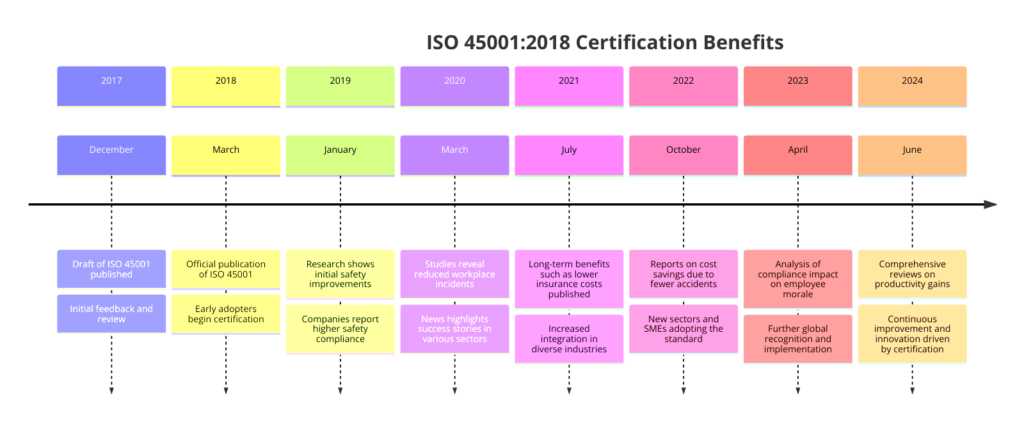
In the early years following its publication, the number of ISO 45001 certifications surged. For example, in 2020, there was a remarkable 405% increase in the number of ISO 45001 certificates compared to the previous year. This substantial rise was largely due to the transition phase where organizations moved from OHSAS 18001 to ISO 45001, indicating a broad adoption of the new standard by companies worldwide. The graph below shows the yearly development:
As of the latest available data, there are approximately 300,000 organizations globally that have achieved ISO 45001 certification. This growth can be attributed to the increasing emphasis on workplace safety and health, driven by regulatory requirements and stakeholder expectations.
Regionally, China leads with the highest number of ISO 45001 certificates, holding about 61% of the total global certifications. Other prominent countries include Italy and the UK, though they have significantly fewer certificates compared to China. The distribution of certifications is also influenced by industry sectors, with the construction, manufacturing, and production sectors showing high adoption rates due to their inherent occupational risks.
The trend of increasing ISO 45001 certifications is expected to continue as more companies recognize the benefits of enhanced occupational health and safety management. These benefits include improved risk management, compliance with legal requirements, and a better reputation among stakeholders.
For further detailed statistics and trends, you can refer to sources like the ISO’s official survey results and industry reports on the growth of ISO 45001 certifications.
Sources:
ISO 45001 Certification Requirements: Implementing ISO 45001:2018
ISO 45001:2018 is an international standard for Occupational Health and Safety Management Systems (OHSMS). It provides a framework for organizations to improve employee safety, reduce workplace risks, and create better, safer working conditions. Implementing ISO 45001 involves several steps and requirements, which are outlined below:
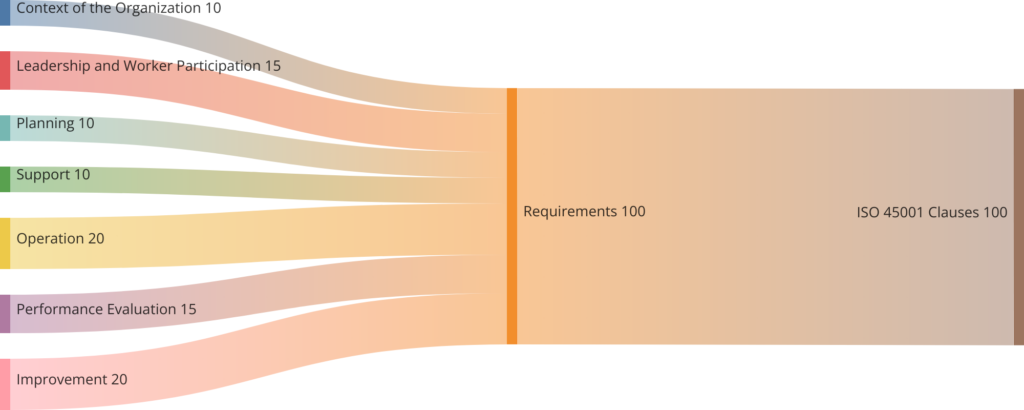
Understanding the ISO 45001 Standard
Before implementation, it’s crucial to have a thorough understanding of the ISO 45001:2018 standard. The standard is divided into several clauses, including:
-
- Scope
-
- Normative References
-
- Terms and Definitions
-
- Context of the Organization
-
- Leadership and Worker Participation
-
- Planning
-
- Support
-
- Operation
-
- Performance Evaluation
-
- Improvement
Conducting a Gap Analysis
Perform a gap analysis to identify the differences between your current OHSMS and the requirements of ISO 45001. This helps in understanding what changes or improvements are needed.
Gaining Leadership Commitment
Top management must be committed to implementing and maintaining the OHSMS. Their involvement is crucial for setting the direction, ensuring adequate resources, and fostering a culture of safety.
Defining the Context of the Organization
Understand the internal and external issues that can affect your OHSMS. This includes identifying stakeholders and their needs and expectations regarding occupational health and safety.
Establishing an OH&S Policy
Develop an occupational health and safety policy that aligns with your organization’s context and strategic direction. This policy should be communicated to all employees and made available to relevant interested parties.
Planning
Planning involves identifying and assessing risks and opportunities related to occupational health and safety. Develop objectives and plans to achieve them, including:
-
- Risk Assessment and Hazard Identification: Identify hazards, assess risks, and determine controls.
-
- Legal and Other Requirements: Identify applicable legal requirements and ensure compliance.
-
- OH&S Objectives and Planning to Achieve Them: Set measurable objectives and plans to meet them.
Support
Ensure that the necessary resources are available to implement and maintain the OHSMS. This includes:
-
- Competence: Ensure that workers are competent and have the necessary skills and knowledge.
-
- Awareness: Make workers aware of the OH&S policy, their contributions to the OH&S management system, and the implications of not conforming to the OH&S requirements.
-
- Communication: Establish a process for internal and external communication regarding OH&S issues.
-
- Documented Information: Maintain and retain documented information as required by the standard.
Operation
Implement the plans and controls to manage OH&S risks. This includes:
-
- Operational Planning and Control: Develop processes to eliminate hazards and reduce OH&S risks.
-
- Emergency Preparedness and Response: Plan for potential emergency situations and test the plans regularly.
Performance Evaluation
Monitor, measure, analyze, and evaluate the performance of the OHSMS. This includes:
-
- Monitoring and Measurement: Regularly measure OH&S performance.
-
- Evaluation of Compliance: Ensure ongoing compliance with legal and other requirements.
-
- Internal Audit: Conduct internal audits to assess the effectiveness of the OHSMS.
-
- Management Review: Top management should review the OHSMS to ensure its continuing suitability, adequacy, and effectiveness.
Improvement
Continually improve the OHSMS by addressing nonconformities and implementing corrective actions. This involves:
-
- Nonconformity and Corrective Action: Identify nonconformities, take corrective action, and prevent recurrence.
-
- Continual Improvement: Proactively improve OH&S performance.
Certification Process
To achieve ISO 45001 certification, an organization must undergo an external audit by a certification body. The process typically involves:
Stage 1 Audit: Review of documentation and readiness assessment.
Stage 2 Audit: On-site/online audit to assess the implementation and effectiveness of the OHSMS.
Certification Decision: If the organization meets the requirements, the certification body issues the ISO 45001 certificate.
Surveillance Audits: Regular audits (usually annually) to ensure continued compliance.
Recertification: After three years, a full re-certification audit is required.
By following these steps and meeting the standard’s requirements, organizations can enhance their safety culture, improve compliance, and achieve certification.
Steps to achieve ISO 45001:2018 to Certification
Implementing ISO 45001:2018 to achieve certification involves a systematic approach to developing, implementing, and maintaining an Occupational Health and Safety Management System (OHSMS). Below are the detailed steps to guide you through this process:
Step 1: Initial Preparation
-
- Obtain a copy of the ISO 45001:2018 standard and familiarize yourself with its requirements and structure.
-
- Secure commitment from top management. Their support is critical for providing necessary resources and fostering a culture of safety.
-
- Establish a team responsible for the implementation. This team should include representatives from different departments and levels within the organization.
Step 2: Conduct a Gap Analysis
-
- Assess your current occupational health and safety practices against the requirements of ISO 45001:2018.
-
- Document the areas where your current practices do not meet the standard’s requirements.
-
- Create a detailed plan to address the identified gaps, including timelines, responsibilities, and required resources.
Step 3: Define Context and Interested Parties
-
- Identify internal and external issues that affect your OHSMS.
-
- Identify stakeholders (e.g., employees, contractors, regulatory bodies) and understand their needs and expectations related to occupational health and safety.
Step 4: Develop OH&S Policy and Objectives
-
- Develop a clear and concise occupational health and safety policy that reflects your organization’s commitment to health and safety.
-
- Set measurable objectives and targets for improving occupational health and safety performance.
Step 5: Plan the OHSMS
-
- Identify hazards, assess risks, and determine opportunities for improvement.
-
- Identify applicable legal and other requirements related to occupational health and safety.
-
- Develop plans to manage risks and achieve OH&S objectives. This includes establishing procedures, controls, and responsibilities.
Step 6: Implement the OHSMS
-
- Ensure that employees are competent and trained to carry out their OH&S responsibilities.
-
- Establish processes for internal and external communication of OH&S information.
-
- Develop and maintain documentation required by ISO 45001:2018, including policies, procedures, and records.
-
- Implement controls to manage identified risks and ensure safe operations.
-
- Develop and implement emergency response plans.
Step 7: Performance Evaluation
-
- Regularly monitor and measure OH&S performance against the set objectives.
-
- Conduct internal audits to evaluate the effectiveness of the OHSMS and identify areas for improvement.
-
- Top management should review the OHSMS periodically to ensure its continuing suitability, adequacy, and effectiveness.
Step 8: Continual Improvement
-
- Identify nonconformities, investigate their causes, and implement corrective actions to prevent recurrence.
-
- Use data from monitoring, measurement, audits, and reviews to drive continual improvement in OH&S performance.
Step 9: Certification Audit
-
- Select a Certification Body: Choose an accredited certification body to conduct the certification audit.
-
- Stage 1 Audit: The certification body conducts a preliminary audit (Stage 1) to review your documentation and readiness for the Stage 2 audit.
-
- Stage 2 Audit: The certification body performs a thorough audit (Stage 2) to evaluate the implementation and effectiveness of your OHSMS.
-
- Address Nonconformities: If any nonconformities are identified, address them promptly and provide evidence of corrective actions to the certification body.
Step 10: Achieving Certification
-
- If the certification body is satisfied with your OHSMS, they will issue the ISO 45001:2018 certificate.
-
- The certification body will conduct periodic surveillance audits (usually annually) to ensure ongoing compliance.
-
- Every three years, a full recertification audit is required to maintain your certification.
Implementing ISO 45001:2018 to achieve certification is a comprehensive process that involves preparation, planning, implementation, evaluation, and continual improvement. By following these steps, organizations can establish a robust OHSMS that enhances workplace safety, complies with legal requirements, and achieves ISO 45001 certification.
What are the Benefits of ISO 45001 Certification?
ISO 45001 certification offers numerous advantages to organizations committed to enhancing their occupational health and safety (OH&S) performance. Below are some key benefits of achieving ISO 45001 certification:
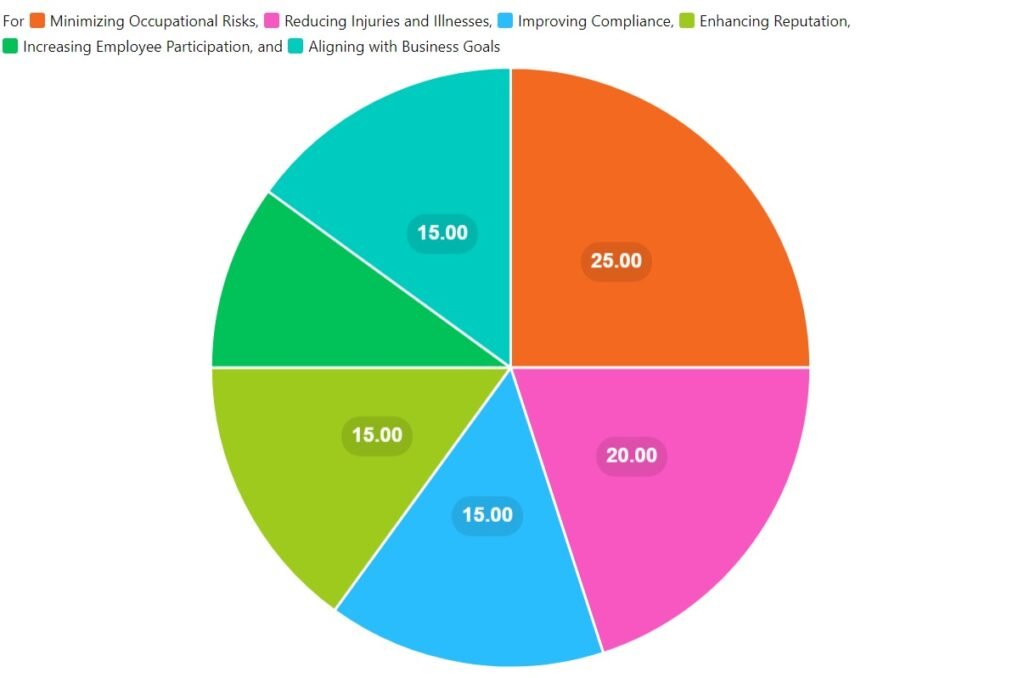
The Pie chart shows the common benefits of ISO 45001:
Other Benefits are:
- Improved Occupational Health and Safety Performance
- Legal and Regulatory Compliance
- Enhanced Reputation and Stakeholder Trust
- Employee Morale and Engagement
- Financial Benefits
- Operational Efficiency
- Global Recognition
- Better Decision Making
- Integration with Other Management Systems
Who Needs ISO 45001:2018 Occupational Health and Safety Management Systems?
ISO 45001:2018 standard is applicable to organizations of all sizes, types, and industries, aiming to reduce workplace risks, enhance health and safety performance, and create a safer working environment.
Below industries commonly use ISO 45001:
Manufacturing and Industrial Companies
Construction Companies
Healthcare Organizations
Service Providers
Energy and Utility Companies
Public Sector and Government Organizations
Retail and Consumer Goods Companies
Mining and Extraction Industries
Small and Medium Enterprises (SMEs)
Click here to apply for ISO 45001:2018 or get in touch with us at +91-8595603096 or support@pacificcert.com









